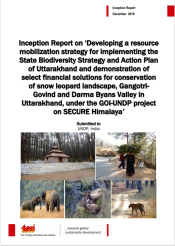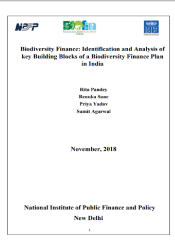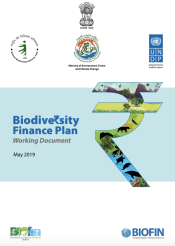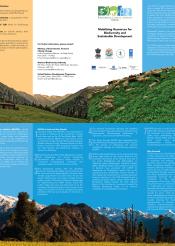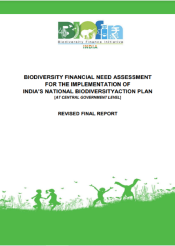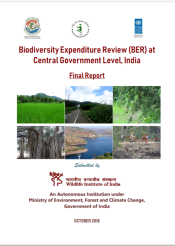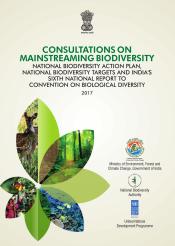India
One of the 17 mega-diversity countries of the world, India is ranked 8th in terms of species richness. In only 2.4% of the world's land area, India harbors 7-8% of all recorded species, including over 48,000 species of plants and over 1,00,000 species of animals. Biodiversity provides resources essential for our survival, social development and economic growth.
Biodiversity management in India is an inter-sectoral subject. The adoption of India’s National Biodiversity Action Plan (NBAP, 2008 & Addendum 2014 to NBAP, 2008) provides the guiding framework to government institutions and other stakeholders for biodiversity management in India.
Public funding is the mainstay of biodiversity finance in the country. The Ministry of Environment, Forest and Climate Change (MoEF&CC) is the nodal ministry providing the core funding and other resources. In addition, there are 24 other central ministries and departments whose schemes and programmes have an impact on biodiversity conservation. At the sub-national level, 28 state governments and 8 Union Territory Administrations provide additional resources.
Private finance is also essential for conservation and sustainable management of biodiversity as it creates significant economic value through services such as food provisioning, carbon storage, water and air filtration, and forms the basis of major value chains like energy, infrastructure, fashion etc. In order to sustain this interdependent relationship and halt biodiversity loss, mobilizing private sector resources is important to transform the way we build, produce and consume. India, in 2014, became the first country in the world to legally mandate Corporate Social Responsibility (CSR) under Section 135 of its Companies Act, thus becoming a frontrunner in recognizing and institutionalizing the role of the private sector towards social and environmental causes.
BIOFIN was launched in India in 2015 to enhance resource mobilization of biodiversity conservation and ensure alignment of private and public, domestic and international finance to the NBAP, the National Biodiversity Targets and related targets and commitments. It is led by the MoEF&CC with support from the National Biodiversity Authority of India and UNDP India.
- Based on policy and expenditure reviews, India has adopted a Biodiversity Finance Plan to implement the NBAP in convergence with relevant national policies and missions.
- For enhancing public finance towards biodiversity conservation, about 116 schemes of 24 central ministries with relevance to biodiversity, have been mapped, with Ministry of Agriculture emerging as an important stakeholder contributing to biodiversity finance.
- For enhancing private finance towards biodiversity, post workshops & consultations with the corporate sector, 5 detailed proposals have been developed based on state level priorities for biodiversity and its suitability for CSR funding, eight thematic fact sheets have been prepared in priority areas and a detailed project has been developed on ‘Eco-restoration on Koyna-Chandoli Wildlife Corridor in Maharashtra’.
- A MoU has been signed between UNDP and the International Crops Research Institute for the Semi-Arid Crops (ICRISAT) for knowledge sharing and technical partnership to enhance the effectiveness of development efforts by mainstreaming technology-enabled agro-biodiversity, climate-resilient agricultural practices and by developing scalable solutions to address India’s priority areas of land degradation neutrality, biodiversity conservation and climate resilience and mitigation.
- UNDP, National Biodiversity Authority (NBA) and the Quality Council of India (QCI) have collaborated to design a Voluntary Certification Scheme on Access & Benefit Sharing (VCS-ABS), to incentivize businesses accessing biological resources to enhance the uptake of the ABS legislation and equitably share the benefits with local communities.
- Under the BIOFIN project and in collaboration with the Ministry of Environment, Forest and Climate Change and Uttarakhand State Biodiversity Board, a State Biodiversity Strategy and Action Plan (SBSAP) and a Resource Mobilization Strategy has been developed for the Himalayan state.
1. Mainstreaming Biodiversity in Agriculture- Increasing the biodiversity-relevance of government-funded schemes in agriculture:
BER process has identified 116 schemes of 24 line ministries having varying degrees of relevance to biodiversity and has indicated that the Ministry of Agriculture is one of the top 7 Ministries contributing to biodiversity finance. The focus of this finance solution is to enhance public finance for agrobiodiversity conservation by enhancing fund flow in biodiversity relevant components of identified schemes of the Ministry of Agriculture (GOI). This is essential to prevent further agro-biodiversity erosion which would result in sustainable agriculture and food security.
2. Corporate Social Responsibility:
Allocation of CSR funds towards biodiversity amounts to nearly 2-3% of total CSR expenditure. This financial solution aims to demonstrate the enhancement of CSR funds for biodiversity conservation in some of the priority areas of NBAP (like wetland restoration, conservation of endangered plant species etc.) and policy reforms for earmarking a certain percentage of CSR funds for biodiversity conservation in identified sectors.
3. Enhancing Resources for Benefit Sharing from Access, Utilization, etc of Bio-Resources:
India is a front runner in the implementation of Access and Benefit Sharing (ABS). This financial solution aims to unlock the full potential of ABS as a finance mechanism by identifying and bringing all currently illegal users of bio-resources within the ambit of ABS. In turn, this would lead to the enhancement of ABS revenues on a sustainable basis.
4. Voluntary Certification Scheme for Incentivisation of Access and Benefit Sharing (VC-I-ABS):
UNDP, National Biodiversity Authority (NBA) and the Quality Council of India (QCI) have collaborated to design a Voluntary Certification Scheme on Access & Benefit Sharing (VCS-ABS), to incentivize businesses accessing biological resources and associated traditional knowledge to enhance the uptake of the ABS legislation and equitably share the benefits with local entities, to bring about bio-resource conservation as well as community upliftment.
Based on a rigorous exercise comprising of technical consultations and guided by the BIOFIN workbook, a customized methodology has been developed in India for assessing the current and projected levels of biodiversity-attributable expenditures in the country and to assess financial needs for implementing the NBAP. As a result of research, analysis and a wide range of consultations and validation exercises, the BER process in India has mapped 116 schemes of 24 central ministries and 29 departments having varied degree of relevance with biodiversity. Projected annual average public finance attributable to biodiversity (from Central and State Govts.) is estimated to be nearly USD 10 billion (@exchange rate of 1 USD=INR 70).
Based on detailed assessments done in consultation with technical experts, the annual average financial requirement for implementing the National Biodiversity Action Plan (NBAP) is estimated to be nearly USD 16.5 billion (2017-18 to 2021-22). Annual average gap in available public resources for implementing the NBAP is estimated to be nearly USD 6.5 billion for the period 2017-18 to 2021-22. Based on the FNA and BER exercise some of the priority areas for enhancing biodiversity finance include- Strengthening and Integration of In-Situ Conservation, Regulation of Invasive Alien Species Introduction and their Management, Development and Integration of Biodiversity Database, Valuation of Goods and Services provided by biodiversity and Use of Economic Instruments and Decision-making Processes & International Cooperation.
The Biodiversity Finance Plan seeks to facilitate the achievement of India’s Biodiversity Vision of conserving biodiversity and promoting its sustainable utilization by way of mobilizing resources through mainstreaming National Biodiversity Targets in relevant national developmental targets like poverty alleviation, food security and elimination of hunger, sustainable livelihoods, women empowerment, health and nutrition, mitigating and adapting to climate change and others. Out of the long list of finance solutions outlined in the finance plan, four solutions have been prioritized for implementation. These include- Corporate Social Responsibility, Mainstreaming Biodiversity in Public Programmes and Schemes, Access and Benefit Sharing and FinTech for Biodiversity Conservation.
